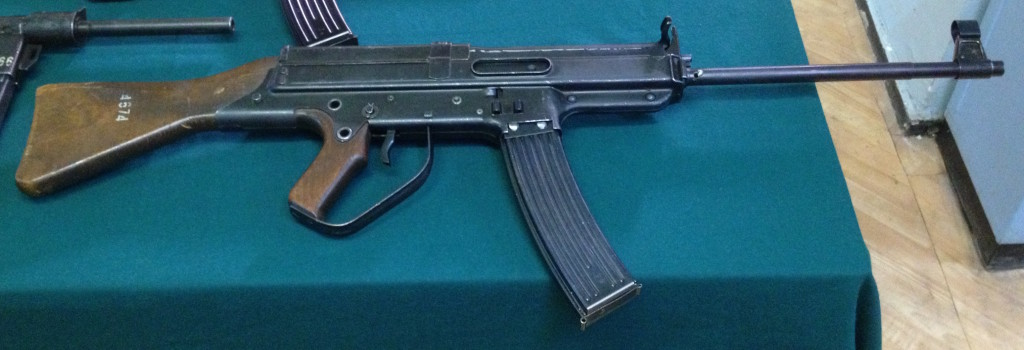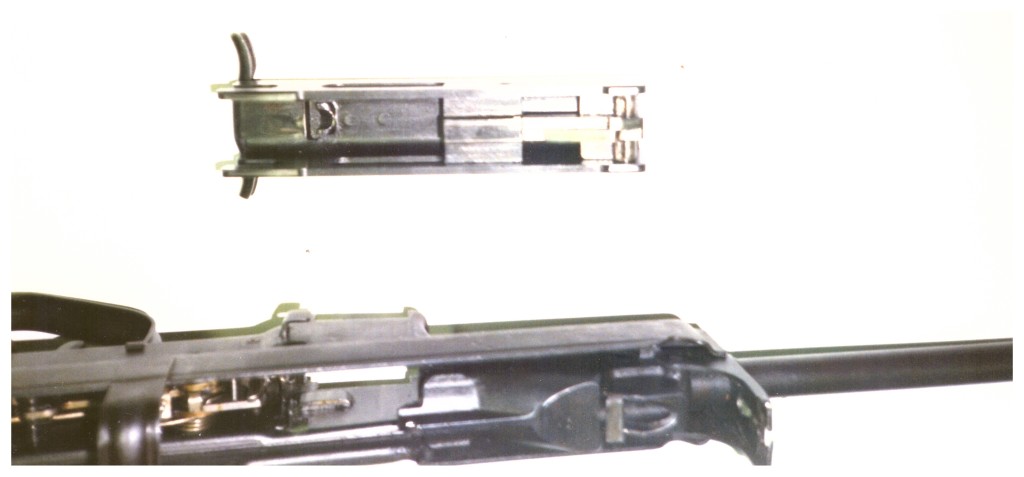Herr Horn (I have seen his name given as both N.V. Horn and V.G. Horn; not sure which is correct) was an engineer working in the R&D department of Mauser at the end of WWII, and he designed one of the many different experimental last-ditch rifles that was conceived in the last years of the war. The requirements for these rifle designs were to use standard MkB-42/MP-43/MP-44/StG-44 magazines, weigh 4kg (8.8lb) or less, have a barrel the same length as an MkB-42 (413mm / 16.3 in), and to be select-fire with a cyclic rate of approximately 500 rpm. And, of course, they should be simpler and cheaper to produce than the standard sturmgewehr while maintaining it’s combat effectiveness. Initially the guns were required to be blowback operated, in the interest of simplifying production and design. Of course, this was problematic – the bolt required to safely contain 8mm Kurz without a locking system would take up a large percentage of the allowable overall weight.
Some designers continued with the blowback system, most notably Barnitzke, with the Volkssturmgewehr Gustloff (aka VG1-5) and Maier with the Gerät 06H. Horn, however, decided to add a sort of gas system to delay the opening of the bolt.
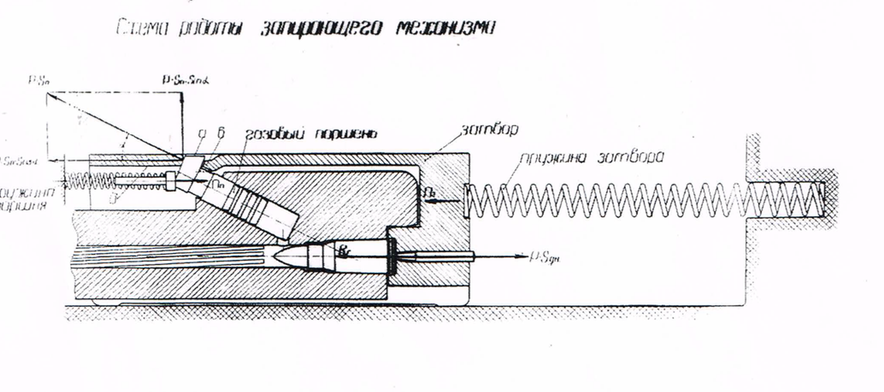
Horn StG action diagram
Horn used a barrel fixed in a stamped sheet metal receiver, with a long bolt much like a pistol slide. Above the chamber was a small gas piston which was connected to a gas port just in front of the chamber. When the rifle was fired, gas pressure would immediately force the piston up and into a recess cut in the slide. The bolt was able to travel rearward only about 1mm before the piston engaged, and then the rearward pressure on the bolt had to fight against the angled surface of the piston engaging in the bolt. This was not a truly “locked” system, but rather one of gas delay, as the piston was intended only to counteract some of the chamber pressure and slow down the opening of the breech.
In early testing it was found that a free floating piston caused problems. If the rifle were manually charged while being pointed downward, gravity could pull the piston forward and cause a nasty double feed type of malfunction. This was addressed by adding a light spring to constantly push the piston downward. The spring force was not enough to have any adverse impact on the firing cycle, but it would counteract gravity.
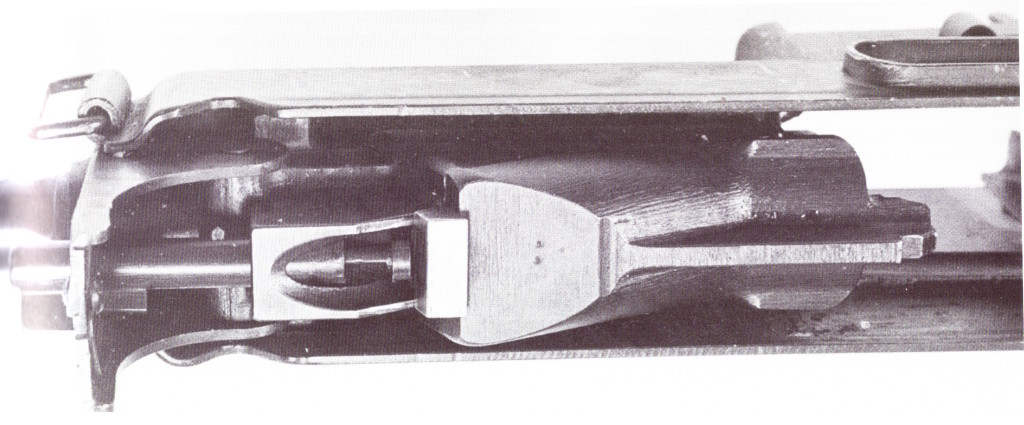
Horn rifle piston in the unlocked position. Note the spring pushing the piston to the right. (photo from Johnston & Nelson’s “The World’s Assault Rifles)
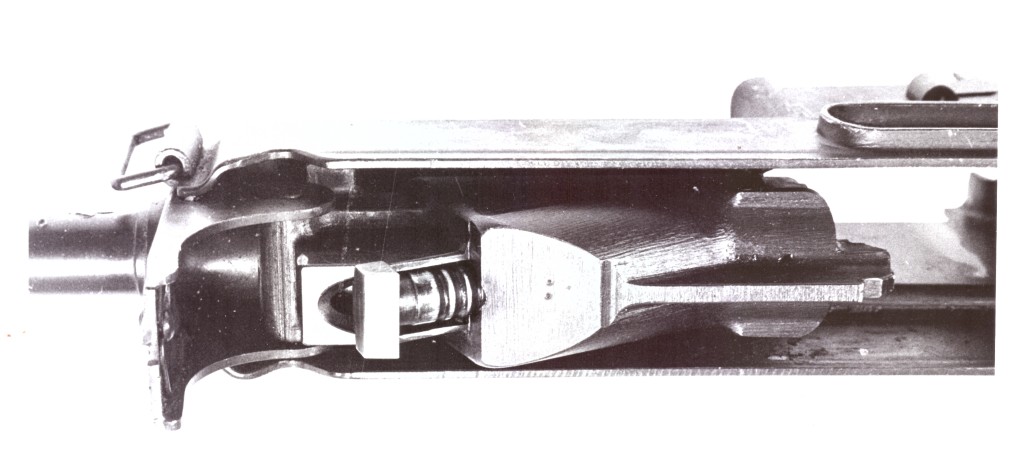
Horn rifle piston in the locked position. Note that the return spring has been removed for this photo.
Another interesting element to take note of is that Horn extended the magazine supports in the front and back of the magwell as compared to the StG-44. These magazines when fully loaded were both heavy and long, and would bounce back and forth on firing, eventually wearing a crease in the front of the magazine where the magwell ended. This would eventually cause functioning problems. The sides of the magazine well could not be altered because of the overtravel stops molded into the magazine stampings, but the front and rear could be extended, which Horn did.
The Horn rifle was hammer fired, and used a quite complex fire control mechanism to prevent out of battery firing and bolt bounce. Either of these would be quite dangerous to the rifle, as the bolt was much lighter than would be required for safe firing without the use of the delaying piston.
The Horn bolt was a long affair rather like an automatic pistol slide, with the actual breechface located in the center and a long surface running forward over the chamber. This forward extension added mass to the bolt and also provided the area for the retarding piston to lock into the bolt. It had two wing-like grasping handles at the front to allow easy grasping.
A handful of these rifles were made during the war – the Russians reported capturing 5 at the testing facility at Kummersdorf and another 4 from various units in the field. Horn was one of the engineers they captured, and after the war he continued to develop the concept briefly for the Red Army. Like Barnitzke, Horn reported that when he arrived in Russia, his office from Mauser had been perfectly recreated for him, right down to his coat hanging behind the door. Only the view out the window was different.
Anyway, Russian experimentation was limited to two examples, I believe. Here is one of them, which appears to have been fitted with a pressure measuring device under the chamber. Note the lack of front sight, where the German production guns used StG-style front sights. Also, note the full-hand style of trigger guard, which was copied form the original German production guns. This rifle was designed with the expectation of use on the Russian front, where the ability to use it with gloved hands was an important factor:

Russian trials Horn rifle – note what appears to be a pressure measuring device under the chamber area (right side – click to enlarge)
In Russian testing after the war, the Horn rifles were found to have a number of deficiencies. For one thing, they were awkward to handle, suffering from being excessively wide and from being poorly balanced, with too much weight too far forward. The charging handles were found to be inconvenient when crawling (they would catch on the ground) and too far forward for easy use when reloading in a prone position. The selector lever was not convenient to use from a firing grip, the buttstock was not attached securely enough, and the magazine release didn’t always work well. Of course, these were rifle still very much in the development phase, and all of these problems could have been addressed.
It seems that Horn had a rather novel and interesting mechanism, and it may well have had real potential had it been developed further. The Russian experiments ended without that development, and I do not know why. Horne did return to the west shortly before his death, but never spoke much about the work he had done in Russia. Interestingly, the only reason he was captured by the Russians was because he had been at the testing center at Kummersdorf when the Russians occupied Berlin – the Mauser facilities and most of their staff ended up in Allied occupation zones.
Three Horn rifles are still in existence, in a museum in Russia. Larry Vickers recently visited and was kind enough to send me these photos of one of the guns (a German example):





I also have some photographs of this rifle being disassembled some time before the advent of digital cameras (they are scanned photographic prints):




